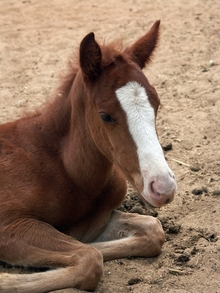According to Oklahoma State University Department of Veterinary Sciences, osteochondritis dissecans(OCD) is a relatively common developmental disease that affects horses of all types. OCD occurs while the foal is in the uterus as the bones are developing from soft cartilage to fully mineralized bone.

Importance of proper bone development in foals
While the foal is in the uterus, the bones are developing from soft cartilage to fully mineralized bone and if this doesn't happen normally a piece can later loosen creating inflammation.
If this process does not proceed normally, a thickened piece of cartilage (or cartilage and bone) develops that is not well attached to the main bone. This abnormal piece loosens over time causing inflammation, which can lead to an excessive amount of joint fluid resulting in swelling.
The most common sign of OCD is excessive swelling of the joint in a young, newly exercising horse. The horse may or may not be noticeably lame. Usually it affects the hock, stifle and fetlock but other joints such as the shoulder can be involved. OCD commonly occurs bilaterally (for instance, both hocks), so it is a good idea to evaluate both joints even if only one has excessive swelling.
OCD fragments will usually show up on x-rays as a piece of bone that appears to float or be unattached to the main bone. However, it is rare that these pieces “float “in the joint. Most are attached to the bone with cartilage that is not visible on radiographs.
OCD may be managed conservatively with rest and joint injections in some instances. The OCD fragment will continue irritating the joint and increase the risk of arthritis developing.
For most cases, surgical removal of the loose fragment is the treatment of choice. Most of these OCD fragments can be removed using a minimally invasive surgical technique called arthroscopy. With arthroscopy, the skin incisions are small, less surgical trauma is caused, the horse may return to exercise sooner, and thorough exploration of the joint may be performed to make sure there are no other problems.
Following proper treatment, the prognosis for athletic use is very good in most cases. Some OCD locations, such as the shoulder, may have a reduced prognosis. The diagnosis, potential therapy and outcome should be discussed with the surgeon during treatment selection.
